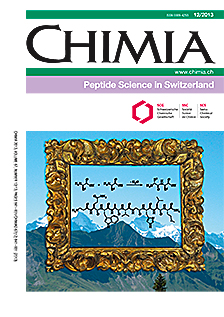Design and Synthesis of 16-Membered Cyclopeptides Active Against Vancomycin-resistant Enterococci (VRE)
DOI:
https://doi.org/10.2533/chimia.2013.916Keywords:
Antibiotic, Cyclopeptide, Macrocycle, Snar reaction, VancomycinAbstract
The design, synthesis and antibiotic activities of the modified carboxylate binding pocket (D-O-E ring) of vancomycin (1) are summarized in this short account. The preliminary structure–activity relationship (SAR) studies indicated that both the structure of the 16-membered macrocycle including the absolute configuration of the modified AA4 unit and the presence of a hydrophobic chain were important for anti-VRE activities of these series of synthetic analogues. Compounds 9c and 9d in which the central amino acid (AA4) of vancomycin was replaced by (2R,3R)-?-hydroxy-?-amino acid and (2R,3R)-?,?-diamino acid, respectively, were found to be useful templates in searching for active compounds against both vancomycin-sensitive and -resistant strains. Two of these compounds (16d and 16n) having an elongated peptide chain at the C-terminal were found to be active against a broad spectrum of both vancomycin-sensitive (Staphylococcus aureus) and -resistant strains (E. faecium, E. faecalis).Downloads
Published
2013-12-18
How to Cite
[1]
J. Zhu, Chimia 2013, 67, 916, DOI: 10.2533/chimia.2013.916.
Issue
Section
Scientific Articles
License
Copyright (c) 2013 Swiss Chemical Society

This work is licensed under a Creative Commons Attribution-NonCommercial 4.0 International License.







